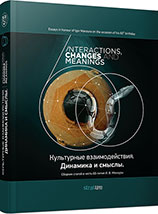«Погребенные дома» и ритуал сожжения поселений Кукутень-Триполья
“Buried Houses” and Cucuteni-Trypillia Settlements Incineration Ritual
Author(s): Natalia B. Burdo, Mykhailo Yu. Videyko
Subject(s): History, Archaeology, Cultural history
Published by: Издательский дом Stratum, Университет «Высшая антропологическая школа»
Keywords: Cucuteni-Trypillian culture; ritual incineration; ‘platforms’; settlement abandonment rite;offerings;
Summary/Abstract: Remains of burnt down structures have been lately considered to be evidence of incineration ritual, common for Trypillian settlements at the final stage of their existence. At the same time, as demonstrated by digs on different settlements (starting from the smallest ones, like Lenkivtsi or Polyvaniv Yar, and up to such giants as Maidanetske, Olkhovets and Kosenovka), the incineration ritual could have been used repeatedly in their history. Meanwhile, the results of some `interim’ rituals — such as burnt houses — were supposed to be fully or partly buried in pits. And only when a settlement was to be abandoned forever, provided that it was not replaced by another settlement, everything was to remain in its place. The rite of `interim’ incineration, as suggested by the data we have collected, had been practiced from Trypillia A to early СІІ stage.The fact that, in most cases, material collected in such `burials’ and from debris of burnt structures found close to the surface is indistinguishable, we can conclude that all such finds can be attributed to the same chronological phase. Its duration, given the package of radiocarbon dates from Maidanetske, could last for 150—200 years. Currently, it would be difficult to ultimately determine the reason for an `interim’ ritual — whether it was a calendar cycle or a certain case, or some special circumstances that imposed this action.We are tempted to conclude that dwellings were not supposed to neighbor debris of burnt houses left on the surface. The latter was supposed to be placed in a pit, while this action could be accompanied by an offering (pit 50 from Maidanetske, etc.). The rite included placing in the pit of meat/bones of sacrificed animals (skulls, horns), ceramic ware (vessels, sometimes a ceramic model of sledge (`the idea of road’ after B. I. Balabina), zoomorphic and, especially, anthropomorphic figurines), tools (an antler hoe was found on the bottom of many such pits, with different degrees of preservation), use of fire.We should also draw attention to the fact that such objects were found at different, sometimes rather remote parts of the settlement at Maidanetske. This means that the `interim’ ritual associated with `burial’ of houses was practiced by inhabitants of several structures of the settlement, who might belong to different groups (large families, clans). This ritual might be used to commit a certain part of the settlement to such social groups.
Book: Культурные взаимодействия. Динамика и смыслы
- Page Range: 175-191
- Page Count: 17
- Publication Year: 2016
- Language: Russian
- Content File-PDF

